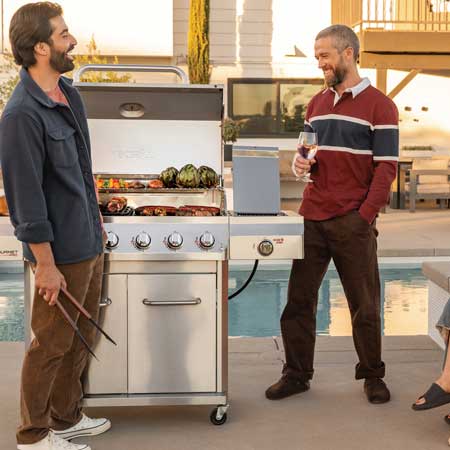Live Better
7 ways to reduce energy bills during summer heat

(Family Features) With temperatures forecasted to run at least 2 degrees higher than historical averages across more than half the country, according to projections from AccuWeather, heat waves may lead to soaring air-conditioning bills this summer.
“The summer is when we see homeowners strategizing about how to keep their homes cool and comfortable while sticking to their household budgets,” said Michael Williford, HVAC service manager at Hiller Plumbing, Heating, Cooling & Electrical. “We work with customers to keep their current HVAC systems running smoothly or upgrade to more efficient systems, which can make a huge difference in their utility bills. In addition, there are many other ways homeowners can keep their energy costs down during the hot summer months.”
Consider these smart, practical, cost-cutting tips for dialing down your energy bills.
Service HVAC Systems Regularly To ensure the best cooling performance and efficiency possible, find a licensed contractor to keep your heating and cooling system well-maintained and serviced throughout the year. There are some tasks many homeowners can handle on their own, like keeping outdoor units free of debris and changing air filters. However, bringing in a professional 1-2 times a year for maintenance and to ensure proper function of ductwork and electrical components is also essential.
To ensure the best cooling performance and efficiency possible, find a licensed contractor to keep your heating and cooling system well-maintained and serviced throughout the year. There are some tasks many homeowners can handle on their own, like keeping outdoor units free of debris and changing air filters. However, bringing in a professional 1-2 times a year for maintenance and to ensure proper function of ductwork and electrical components is also essential.
Use Appliances During Non-Peak Hours
Rather than using stoves, ovens and clothing dryers in the afternoon hours, consider doing so early in the morning or late in the evening. Peak time for many electricity providers is noon-6 p.m., meaning using appliances that heat up your home outside of this timeframe when conventional heating and cooling systems are likely running full throttle can help lower energy costs.
Upgrade Your Systems to an Energy-Saving Heat Pump
The Inflation Reduction Act (IRA) incentivizes homeowners who opt for energy-efficient HVAC upgrades, including qualified heat pumps, which can boost seasonal energy efficiency ratios and increase efficiencies. For example, Mitsubishi Electric heat pumps provide more energy-efficient cooling that may equal cost and energy savings as well as a reduced carbon footprint for homeowners. These systems are equipped with inverter or variable-speed technology that allows systems to automatically ramp up or down the required amount of energy depending on the room’s capacity. Although annual savings vary, some homeowners can save as much as $1,000 per year by switching to an all-electric heat pump.
Fire Up the Grill
When temperatures soar, use the grill for cooking to help lower energy usage and save on air-conditioning costs. Alternatively, toaster ovens, air fryers and slow cookers use less energy than larger conventional stoves or ovens. Get creative by cooking a pizza in a chiminea or smoking favorite meats as alternatives to using your oven.
Stop Cooling Empty Rooms
One mistake many homeowners make is forgetting to adjust their temperature settings when leaving the house. Whether you’re headed to the beach for the weekend or just headed to work for the day, blasting the air conditioner in an empty house can result in unnecessarily high utility bills. Multi-zone, all-electric heat pumps like those from Mitsubishi Electric allow homeowners to set the comfort level and adjust the temperature in each room, so you don’t have to waste energy cooling unoccupied rooms. With a smartphone app, you can even adjust the settings remotely.
Install a Smart Electric Panel
Installing a smart electrical panel alongside an all-electric heat pump enables homeowners to monitor and control energy consumption on-site or remotely using a smartphone for better overall efficiency and utility cost savings.
Harness the Sun’s Energy with Solar Panels
According to the Office of Energy Efficiency & Renewable Energy, the amount of sunlight that strikes the Earth’s surface in 90 minutes could power the world’s total energy usage for a full year. Investing in solar panels can help decrease energy bills and increase your home’s sustainability. Additionally, some utility providers and government entities, including the IRA, offer incentives to help reduce installation costs. Plus, solar-sourced power pairs well with all-climate heat pumps, which require minimal electricity to operate.
Find more ideas to dial down energy usage (and bills) this summer at MitsubishiComfort.com.
Photos courtesy of Shutterstock
SOURCE:
Mitsubishi Electric
Live Better
Homeowners handbook: Navigating new HVAC refrigerants

(Family Features) Homeowners may not realize it, but one compound impacts their lives nearly every day: refrigerant. Capable of transforming from liquid to gas and back again, it absorbs and transfers heat as a key part of air conditioning and heat pump systems that keep you comfortable no matter the weather.
As part of your air conditioner or heat pump system, it helps transfer heat and humidity out of your home for cooling or draws heat from outdoor air and brings it inside for heating. However, while concerns about climate change heat up, government leaders are enacting policies that enforce greater control over the anticipated global warming potential (GWP) of refrigerants.
In fact, the Environmental Protection Agency (EPA) is limiting the GWP of refrigerants in equipment starting in 2025. At the same time, the EPA is implementing a phasedown on the supply of existing, higher GWP refrigerants.
The changes include a phasedown of high-GWP refrigerants commonly used in home air conditioning and refrigeration, introduction of alternative refrigerants with lower GWP that maintain efficiency and requiring manufacturers to comply with new standards for energy efficiency and environmental impact.
Despite these policy updates, you may not necessarily need a new air conditioner or heat pump. Here’s what homeowners need to know, courtesy of the experts at Carrier, a world leader in high-technology heating, air conditioning and refrigeration solutions:
Environmental Awareness and the Impact on Existing Home Systems
Transitioning away from high-GWP refrigerants contributes positively toward reducing your carbon footprint. These anticipated changes aim not only at reducing environmental impact but also at promoting technological advancements in heating and cooling solutions that benefit both consumers and the planet over time. If you have an existing system using older refrigerants like R-22 or R-410A, it can still be serviced; however, it’s possible repair costs may increase due to reduced availability.
Maintenance and Servicing
Regular maintenance becomes more crucial as systems age. Ensure your HVAC technician is knowledgeable about the new requirements and safely handling different types of refrigerants.
Considerations for New Purchases
When purchasing a new air conditioner or heat pump, be sure to check for energy efficiency ratings that align with the updated regulations and look for models using low-GWP refrigerants. For example, Puron Advance from Carrier will replace existing refrigerants in all its residential ducted and ductless and light commercial products. This innovative refrigerant, also known as R-454B, not only meets the EPA’s anticipated GWP limits for refrigerants but exceeds the new requirements with a GWP of 466, a 75% reduction compared to R-410A.
Incentives and Rebates
If you’re shopping for a new air conditioner or heat pump, keep an eye out for government incentives or rebates aimed at encouraging homeowners to upgrade their systems in compliance with new standards.
Consult Professionals
Owning a home is a lot of work on its own, and EPA regulations on your cooling and heating systems may be the furthest thing from your mind. If you believe you’re due for service or a new system, engage HVAC professionals – like the trusted experts at Carrier – who are up to date on regulatory changes. Always check local regulations for specific details applicable in your area since policies can vary by region beyond federal guidelines.
To find more information on the changes or connect with an HVAC professional, visit Carrier.com/Residential.
SOURCE:
Carrier
Live Better
5 things funeral directors wish everyone knew

(Family Features) Most people don’t want to think about death – let alone talk about it. When the time comes, families often find themselves overwhelmed, not only by grief but by the many decisions that need to be made quickly.
Funeral directors witness this every day. They see the stress and confusion that can come when there is no plan in place and the peace of mind that comes with thoughtful preparation.
After consulting funeral directors nationwide, the National Funeral Directors Association (NFDA) uncovered five things they wish families knew before a death occurs.
- It’s Never Too Early to Start Planning
While everyone knows death and taxes are inevitable, conversations about death are often avoided.
Simply documenting your wishes and discussing your preferences with your family can alleviate the difficult decisions your loved ones will have to make in the future. Speak with a funeral director to explore the many options for planning a meaningful funeral.
- Legal and Financial Details Can Cause Unexpected Issues
Families often don’t realize power of attorney ends at death, meaning a designated person can no longer make decisions or access bank accounts once an individual dies.
To avoid complications, consider adding a trusted loved one to your bank account and ensure life insurance beneficiaries are up to date. Too often, deceased individuals leave minor children, deceased spouses or former partners as beneficiaries, leading to legal and financial challenges.
- Final Wishes Shouldn’t Be In Your Will
Many people believe the best place to document their final wishes is in their will. However, wills are often not read until after funeral services take place, making them an unreliable way to communicate last requests. Instead, discuss and document your wishes with family members or a trusted funeral professional who can keep your wishes on file until there is a need.
- There Are a Variety of Memorialization Options
End-of-life planning offers more choices than many realize. While burial remains a common preference, cremation is an increasingly popular choice and can even include a viewing and funeral service. Additionally, eco-friendly options, such as alkaline hydrolysis, natural burial and natural organic reduction are becoming more widely available for those seeking green memorialization. In fact, according to NFDA’s 2024 Consumer Awareness and Preferences Study, 68% of respondents expressed interest in green funeral options.
Exploring these possibilities with a funeral professional can help ensure your final arrangements reflect your values, traditions and personal wishes.
- Funeral Directors Don’t Just Manage Funerals – They’re Trusted Guides In Honoring Life
Funeral directors play a vital role in helping families create meaningful services that reflect their loved one’s life, values and traditions. Whether planning ahead or facing a recent loss, funeral professionals provide expertise, compassionate care and personalized guidance during one of life’s most difficult moments.
Choosing the right funeral director is an important decision and finding someone who understands your needs can make all the difference in honoring your loved one in a personal and meaningful way.
Start the conversation today by talking about end-of-life planning. It isn’t easy, but it’s one of the most important conversations you can have with your loved ones. A little planning today can make a world of difference tomorrow.
Use comprehensive resources like RememberingALife.com, which is designed to guide families through every stage of the journey, including planning, funeral options and grief resources. The site offers valuable tools and support, such as the “Find a Funeral Home” tool to connect families with compassionate, local funeral directors and much more.
Photo courtesy of Shutterstock
Live Better
Gear up for grilling season

(Family Features) As the days get longer and the temperatures rise, it’s time to fire up the grill and elevate your outdoor cooking game. Whether you’re a seasoned grill master or just starting out, success comes down to three essentials: quality ingredients, the right seasonings and reliable equipment that gives you full control over heat and timing.
If you’re ready to turn up the heat this season, explore high-performance grilling solutions from Nexgrill – built to match every cooking style and skill level. From backyard barbecues to weeknight dinners under the open sky, its lineup is designed to help you serve up unforgettable flavors all season long. Visit nexgrill.com to learn more and get inspired.

Unlock a New Level of Outdoor Cooking Versatility
Transform your backyard into a chef-inspired kitchen with the Gourmet Pro 6-Burner Stainless Steel Gas Grill featuring the Griddle Max Cooking System. Designed to go beyond traditional grilling, this powerhouse lets you grill, saute, griddle and smoke all at once or on demand. The innovative system makes it easy to achieve restaurant-quality results, delivering unmatched versatility for any meal. Built with stainless steel burners, angled flame tamers and porcelain-coated cast-iron cooking grids, it ensures consistent heat and fewer flare-ups. With 811 square inches of cooking space, six main burners and a high-heat searing side burner, you’ll get 75,000 BTU of total cooking power.

Take on Breakfast, Lunch and Dinner
From sizzling fajitas at your backyard bash to early-morning pancakes before your next adventure, the Daytona 4-Burner Propane Gas Griddle delivers the heat, flavor and performance you need. Designed for versatility, this powerhouse features a 792-square-inch cooktop and four stainless steel burners, giving you the space and control to cook multiple dishes at once. Built-in convenience comes standard with dual side shelves, a lower storage rack to keep tools within reach and a removable grease cup for quick and easy cleanup. When it’s time to pack it in, a heavy-duty lid protects your cooking surface.

From Kitchen to Patio, It Goes Where You Go
Grilling isn’t just for the backyard. When weather or space keeps you inside, the Fuse 22-inch Electric Griddle delivers bold, flame-free cooking anywhere there’s an outlet. Ultralightweight and easy to transport, it’s built for seamless indoor-outdoor use. With 308 square inches of edge-to-edge heat, a durable nonstick surface and digital temperature control, this electric flattop offers precision and power. A hinged lid with a built-in viewing window locks in heat and flavor so you can cook efficiently. From weekday breakfasts in the kitchen to weekend feasts on the patio, it can be your all-access pass to delicious, flexible cooking – wherever life takes you.
SOURCE:
Nexgrill
-

 NEWS2 years ago
NEWS2 years ago2 hurt, 1 jailed after shooting incident north of Nocona
-

 NEWS2 years ago
NEWS2 years agoSuspect indicted, jailed in Tia Hutson murder
-

 NEWS2 years ago
NEWS2 years agoSO investigating possible murder/suicide
-

 NEWS2 years ago
NEWS2 years agoWreck takes the life of BHS teen, 16
-

 NEWS2 years ago
NEWS2 years agoMurder unsolved – 1 year later Tia Hutson’s family angry, frustrated with no arrest
-

 NEWS2 years ago
NEWS2 years agoSheriff’s office called out to infant’s death
-

 NEWS2 years ago
NEWS2 years agoBowie Police face three-hour standoff after possible domestic fight
-

 NEWS2 years ago
NEWS2 years agoDriver stopped by a man running into the street, robbed at knifepoint






